How Do I Know What Type of Fish I Have
Identifying fishes
A knowledge and appreciation of coral reef fishes will help make your underwater experience much safer, educational, exciting and enjoyable.
- How to identify fishes
- Body shape and profile
- Markings and body patterns
- Mouth, fin and tail shapes
- Habitat and behaviour
- Distinguishing look-alikes
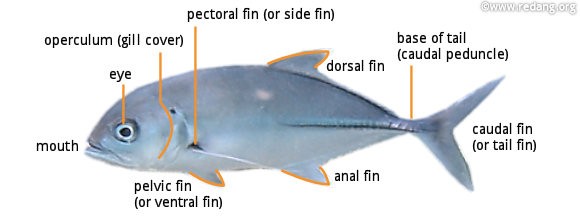
The diagram above shows the different parts of a fish commonly used in fish identification. The next time you look at fishes, observe how these parts differ across fish species. Different species have different sizes, different body, mouth, fin and tail shapes, different number of dorsal fins as well as different colours and markings on their bodies. Pay attention also to the habitat or surroundings where the fish lives, like coral areas, crevices and holes or sandy bottoms. Observe its behaviour, whether it is lying still on the seabed, swimming freely individually or in schools, and the company it keeps. Even if you do not recognize the fish, taking note of these characteristics will help you identify it later when you are thumbing through fish reference books.
Note that the young (juvenile) of some fish species like the batfish and sweetlips may look different from the adults. Some fishes also mimic other species, like the bluestriped fangtooth blenny mimicking the cleaner wrasse, which make identification more difficult.
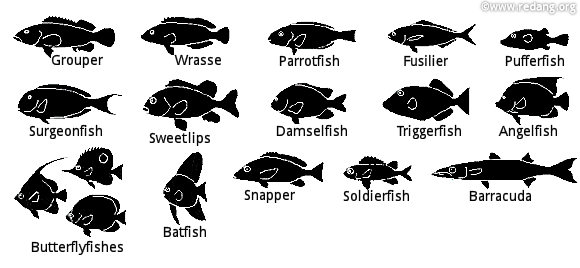
The simplest way to identify fishes is by their physical shape and appearance. Everyone can easily recognize a shark or a dolphin because of their distinctive shapes. Different species have different profiles when viewed from the side, top or front. Some are slim and elongated, others fat and rounded. The diagram above shows the shapes of many common fishes.

Many colourful reef fishes are adorned with pretty patterns and markings on the body. Often, their common names include the kind of markings found on them. For example, the 'six-bar regal angelfish' has 6 vertical bars on its body. The 'chevron barracuda' has visible chevron markings. The 'saddled butterflyfish' has saddle markings while the 'banded wrasse' has bands. Some of these markings act as camouflage to break the outline of the fish, while others like the false eye spot are used to confuse predators.
Mouth shapes

The size and position of mouths of fishes differ and there can also be differences in the relative sizes of their upper and lower lips. The mouth can be right at the front or at the bottom of the head. They can be elongated or protruded, making the fish appear to have a long nose. Lips can be thin or thick, sometimes one lip might be bigger than the other, or one lip may protrude more than the other. Groupers and rock cods are easily identified by their superior mouths, where the lower lip or jaw protrudes. Sharks have inferior mouths, while parrotfishes have terminal mouths. Needlefish have elongated mouths, while goatfishes have barbels (whisker-like appendages) under their mouths.
Fin shapes

Although most fishes have the usual set of fins at the top (dorsal fin), side (pectoral fin) and bottom (pelvic and anal fins), the size, shape and number of fins may differ. Groupers, damsels, wrasses, surgeonfish and angelfish have one continuous dorsal fin, while barracuda, goatfish, gobies, soldierfish and cardinalfish have 2 dorsal fins. It is not always easy to make out the fins visually as they can be very translucent and thin while the soft flowing dorsal fins on some species can appear folded down close to the body.
Tail shapes

The tails of fishes also come in a variety of shapes. Fusiliers, jacks, soldierfishes and cardinal fishes typically have forked tails, while wrasses and parrotfishes typically have truncate or rounded tails. Tuna and some jacks have lunate tails that are crescent shaped while lanceolate tails, such as those on coelacanths and comet fishes, look like a lance or arrow head.
Certain fishes like scorpionfish, goatfish, lizardfish, gobies and flounders, live on the seabed and are often seen resting on or buried in the sand, coral or rocks. Jawfish, soldierfish, cardinals and eels like to live in holes or crevices while others like jacks, trevallies, sharks and wrasses, prefer to swim around in the open.
Finally, observe the behaviour of the fish when resting, feeding or moving. Lizardfish and hawkfish like to sit motionless on coral, darting away into a crevice nearby when disturbed. Snappers, fusiliers and cardinals prefer to congregate in schools. Some swim in a peculiar fashion, like wrasses 'flapping' their pectoral fins like a bird and gobies 'walking' along the seabed using their pectoral fins. Others sleep in the day and are active mainly at night like soldierfish and cardinalfish.
Sometimes, at first glance, it is hard to tell two similar looking fishes apart. In such cases, look out for distinguishing features that may be present in one species and absent in the other, such as barbels (whiskers), spines and fin arrangements. On tiny fishes, these features may be harder to see so you'll have to study the fish carefully. Shown below are distinguishing features between some common fishes that appear similar.
Angelfish and butterflyfish
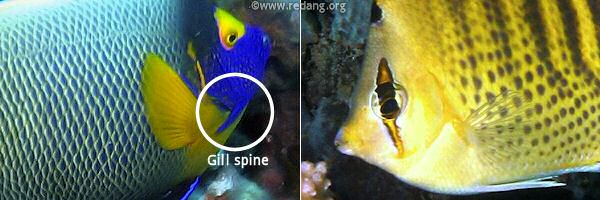
Angelfish (left) have a visible spine on the gill cover which is absent in butterflyfish (right). Angelfish are usually larger, growing up to 60cm in length and usually have more brilliant patterns and colours and larger scales. Butterflyfish are smaller, growing up to 30cm in length. Many have bright orange and yellow markings and often have false eye spots near the tail.
Bannerfish and Moorish Idol
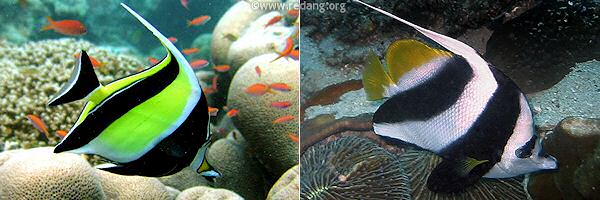
Moorish idols (left) have black tails, a predominantly black face and tubular white nose with a yellowish-orange patch while bannerfish (right) have yellow tails. 'Gill' in the movie 'Nemo' is a moorish idol.
Gobies and blennies
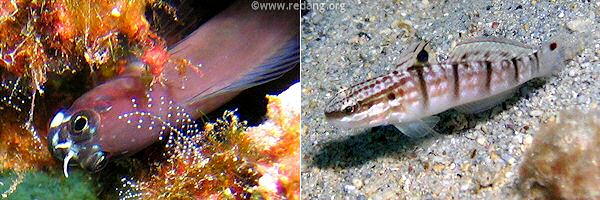
These fishes can be tiny and are often partially hidden, making identification difficult. Blennies (left) have a single continuous dorsal fin while gobies (right) have 2 distinct dorsal fins. Many blennies also have 'eyelashes' or feelers near the eyes and faces that resemble grasshoppers. The pelvic fins on gobies are joined at the base forming a little cup for support, while the pelvic fins of blennies are separate and located clearly behind their pectoral fins. Prawn gobies are easier to identify as they live with a prawn as a housemate. The goby stands guard at the entrance to the hole while the prawn cleans out their living quarters.
Napolean wrasse and bumphead parrotfish
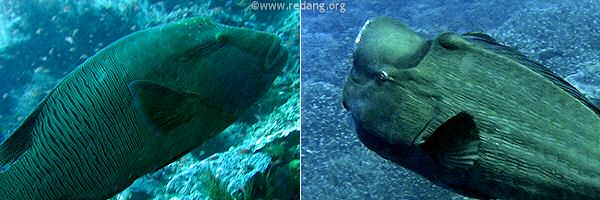
Both of these large fishes have pronounced bumps (or humps) on their heads especially in mature adults. The bump on the Napolean or Humphead wrasse (left) is located on the forehead while the bump on the parrotfish (right) appears at the top of the head. The Napolean has a longer protruding jaw with subtle striped patterns on its face while the parrotfish has a beaked mouth and light stripe running down its nose.
Pufferfish and porcupinefish
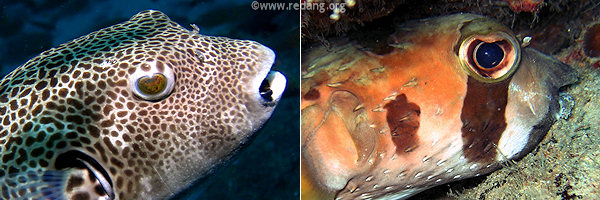
Both can inflate their bodies by sucking in water but while the pufferfish (left) has a smooth body, the porcupinefish (right) has many small spines all over its body. When the spines are folded flat against the body, they look like little uneven bumps on the body of the porcupinefish.
Squirrelfish and soldierfish
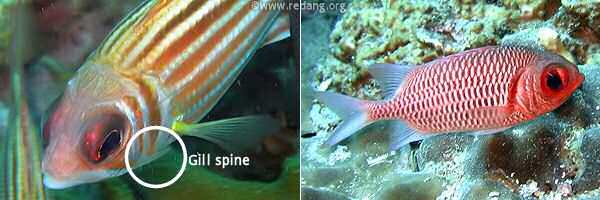
Both are predominantly red, have large eyes and large scales, but only squirrelfish (left) have a visible spine on the gill cover that is absent in soldierfish (right). Many squirrelfish species also have horizontal stripes across the length of the body.
Stonefish and scorpionfish
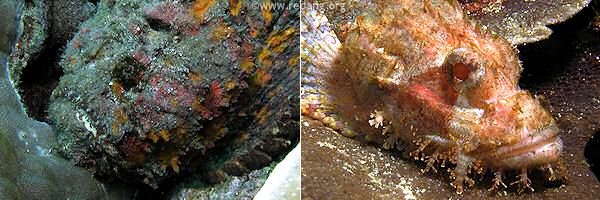
Both look like stones or corals and are very well camouflaged. The stonefish (left) has a short and wide upturned mouth on a flattened face which gives it a distinct grumpy appearance. Its eyes are set deeper into the head. From the top, it looks more rounded with the head and torso looking top-heavy and a tail that is often curled slightly to one side. The scorpionfish (right) looks more like a fish with a slender body, longer snout and a mouth that is angled but not grumpy.
Surgeonfish and other fish
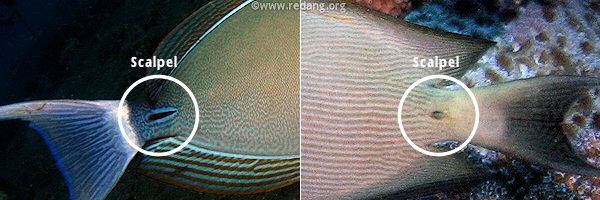
Surgeonfish have a scalpel-like spine at the base of the tail which is absent in other fishes. When folded, the spine may not always be clearly visible and sometimes appear as a fine horizontal line. The character 'Dory' in the movie 'Nemo' is a palette surgeonfish.
How Do I Know What Type of Fish I Have
Source: https://www.redang.org/fishid.htm
0 Response to "How Do I Know What Type of Fish I Have"
Post a Comment